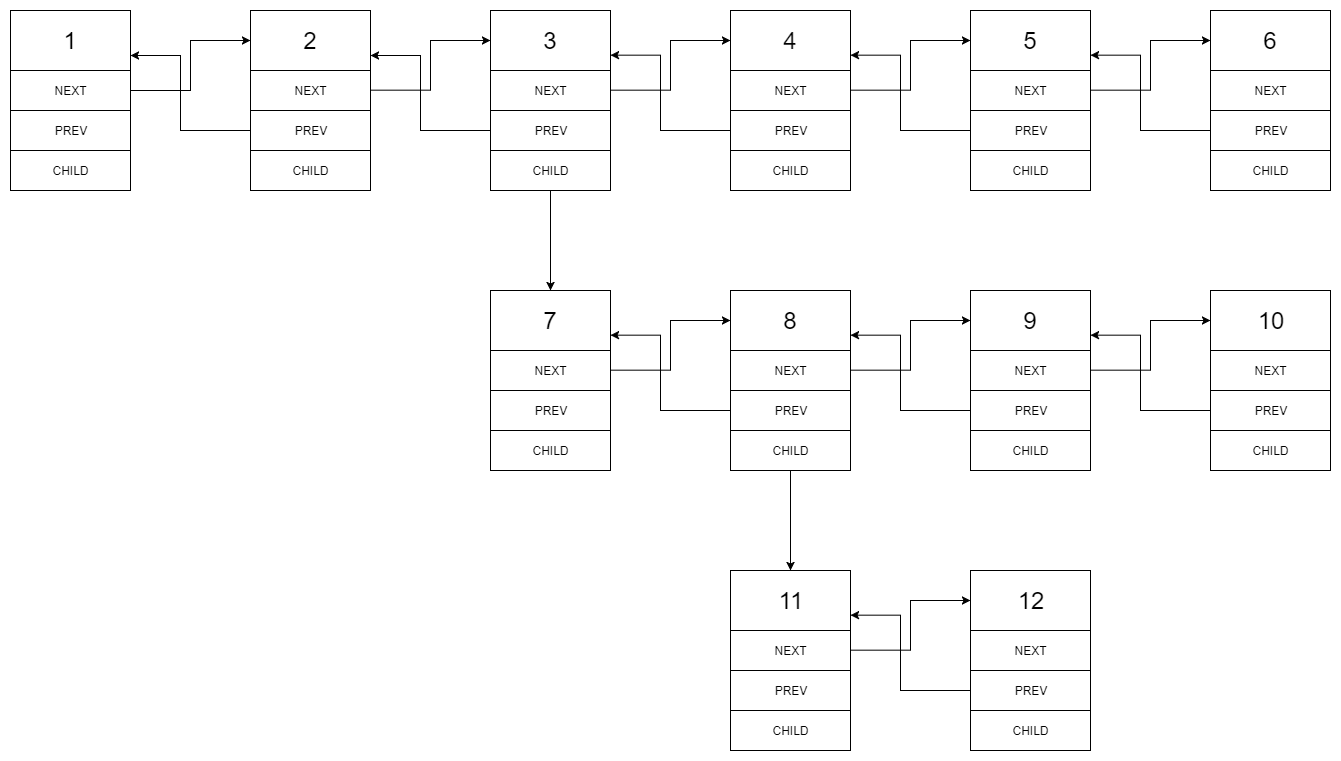Flatten a Multilevel Doubly Linked List
Created: March 23, 2020 by [lek-tin]
Last updated: March 23, 2020
You are given a doubly linked list which in addition to the next and previous pointers, it could have a child pointer, which may or may not point to a separate doubly linked list. These child lists may have one or more children of their own, and so on, to produce a multilevel data structure, as shown in the example below.
Flatten the list so that all the nodes appear in a single-level, doubly linked list. You are given the head of the first level of the list.
Example 1
Input: head = [1,2,3,4,5,6,null,null,null,7,8,9,10,null,null,11,12]
Output: [1,2,3,7,8,11,12,9,10,4,5,6]
Explanation:
The multilevel linked list in the input is as follows:

After flattening the multilevel linked list it becomes:

Example 2
Input: head = [1,2,null,3]
Output: [1,3,2]
Explanation:
The input multilevel linked list is as follows:
1---2---NULL
|
3---NULL
Example 3
Input: head = []
Output: []
How multilevel linked list is represented in test case:
We use the multilevel linked list from Example 1 above:
1---2---3---4---5---6--NULL
|
7---8---9---10--NULL
|
11--12--NULL
The serialization of each level is as follows:
[1,2,3,4,5,6,null]
[7,8,9,10,null]
[11,12,null]
To serialize all levels together we will add nulls in each level to signify no node connects to the upper node of the previous level. The serialization becomes:
[1,2,3,4,5,6,null]
[null,null,7,8,9,10,null]
[null,11,12,null]
Merging the serialization of each level and removing trailing nulls we obtain:
[1,2,3,4,5,6,null,null,null,7,8,9,10,null,null,11,12]
Constraints
- Number of Nodes will not exceed
1000. 1 <= Node.val <= 10^5
Solution (recursive dfs)
Time: O(n)
Space: O(n)
"""
# Definition for a Node.
class Node:
def __init__(self, val, prev, next, child):
self.val = val
self.prev = prev
self.next = next
self.child = child
"""
class Solution:
def flatten(self, head: 'Node') -> 'Node':
if not head:
return head
dummy = Node(None, None, None, None)
dummy.next = head
self.dfs(dummy, head)
# delete prev pointer for head
dummy.next.prev = None
return dummy.next
def dfs(self, prev, curr):
if not curr:
return prev
curr.prev = prev
prev.next = curr
pending_next = curr.next
# if child doesn't exist, it will return curr immediately
# otherwise, dfs will continue flattening the child level
pending_tail = self.dfs(curr, curr.child)
# delete child pointer for curr
curr.child = None
return self.dfs(pending_tail, pending_next)
Solution (iterative dfs)
Time: O(n)
Space: O(1)
"""
# Definition for a Node.
class Node:
def __init__(self, val, prev, next, child):
self.val = val
self.prev = prev
self.next = next
self.child = child
"""
class Solution:
def flatten(self, head: 'Node') -> 'Node':
if not head:
return None
curr = head
while curr:
# flatten child level first
if curr.child:
pending_next = curr.next
curr.child.prev = curr
curr.next = curr.child
nextLevel_prev = curr
while nextLevel_prev.next:
nextLevel_prev = nextLevel_prev.next
if pending_next:
nextLevel_prev.next = pending_next
pending_next.prev = nextLevel_prev
# clear child pointer for curr
curr.child = None
# curr will move onto the already flattened child level head now
# e.g., 3 -> 7
curr = curr.next
return head